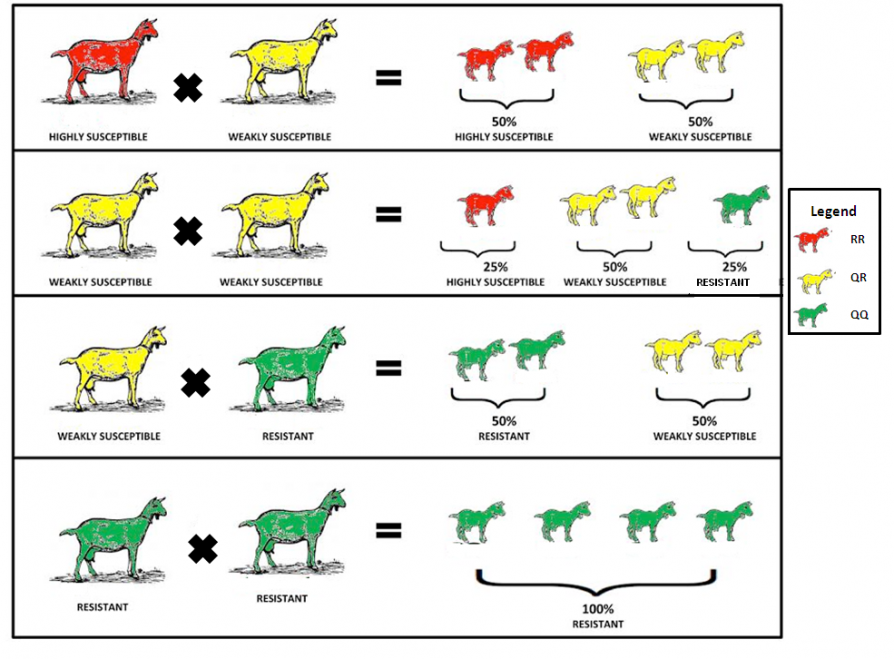Ontario Goat (OG) has recently completed a scrapie genotyping project in partnership with Trent University. The goal of the project was to identify genes that associated with resistance to scrapie. Scrapie is a slow progressing disease of sheep and goats that affects the central nervous system. It is caused from a buildup of mutated proteins, known as prions, in the brain. In order for a goat to be affected by scrapie, two things are required, one is that the goat needs to be exposed to the prion proteins in their environment, and two the goat needs to be genetically susceptible. The results from the project identified different genes in different goat breeds that are associated with resistance or susceptibility, so different breeding strategies are needed for different breeds.
Ontario Goat has received a lot of interest in learning more about how to genotype goats for scrapie and how to set up a breeding plan. To help answer some of these questions, we’ve put together a short list of frequently asked questions.
How does the genotyping work?
Genotyping involves collecting a sample of DNA. In this case, the preferred DNA sample for genotyping goats for scrapie is a nasal swab. Swabs can be obtained from the Natural Resources DNA Profiling and Forensic Centre at Trent University. Once the swabs have been collected, they are sent back to the lab for DNA analysis.
How much does it cost?
The cost of genotyping goats for scrapie is $50.00 per goat, and this includes the cost of the swabs.
Who do I contact about testing my goats?
Mubrouka Elharram has been overseeing the genotyping of goats and can be contacted at the Natural Resources DNA Profiling and Forensic Centre at Trent University, melharram@gmail.com or 705-748-1011 ext. 7120.
Is genotyping the same as testing goats for scrapie?
Genotyping is not the same as testing goats for scrapie, genotyping will only tell you if your goat is susceptible, weakly susceptible, or resistant to scrapie. It will not tell you if your goat has the disease.
What does it mean to be susceptible, weakly susceptible or resistant to scrapie?
Scrapie is one of the few diseases where resistance or susceptibility only involves a few genes. The results from the scrapie genotyping project revealed that goats homozygous for a particular amino acid at a specified location in the genome are susceptible, goats that are heterozygous are weakly susceptible, and goats that are homozygous for a different amino acid at that position are resistant. The location in the genome and the amino acid residues that confer resistance or susceptibility are different depending on the breed of goat.
What is the best way to breed for scrapie resistance in my herd?
The fastest way to improve scrapie resistance is to use a resistant buck to breed to a resistant doe. The kids will all be resistant, however finding a resistant buck and a resistant doe to breed may be difficult. Other options are to breed a resistant buck with a weakly susceptible or susceptible doe which would result in kids that are resistant and weakly susceptible. Using this method, you can reduce the cost of testing by only testing your breeding stock.
What if none of my goats are resistant? How can I improve resistance in my herd?
If none of your goats turn out to be resistant to scrapie, there is another option. Breeding a weakly susceptible buck with a weakly susceptible doe will result in a 25% chance the kids are resistant, a 50% chance that the kids are weakly susceptible, and a 25% chance that one is resistant. For example, in a breeding of two weakly susceptible goats, and the doe has four kids, one kid will be resistant, two will be weakly susceptible, and one will be susceptible. This method may take longer to build up resistance in the herd but can be an economical way to improve resistance over time. In some cases the results from the genotyping can show that all of your goats are susceptible, in this case you can purchase a buck that is resistant or weakly susceptible to use for breeding. It is also important to remember that if your goats are susceptible, it does not mean they will get scrapie, if you follow good biosecurity and limit contact with goats from outside your herd you can keep scrapie off your farm.
Is genotyping goats for scrapie recognized by Scrapie Canada?
Currently Scrapie Canada recognizes genotyping as a tool to prevent disease for sheep and goats, but CFIA will only spare genetically resistant sheep in the event of a mass depopulation. More research is needed before goats on the voluntary scrapie flock certification program that are genetically resistant are spared during a depopulation.
With the advancement of DNA technology for goats, breeding for disease resistance is becoming increasingly popular. For diseases such as scrapie where only a few genes are involved, the breeding strategies are quite simple and can be a useful tool for improving overall herd health. In goats breeding for scrapie resistance isn’t as straight forward as it is for sheep so different strategies need to be used for different breeds. For more information on breeding strategies check out our upcoming Alliance magazine article, Breeding Strategies for Scrapie Resistance.
Funding for this project was provided in part by Growing Forward 2, a federal, provincial, territorial initiative. The Agricultural Adaptation Council assists in the delivery of Growing Forward 2 in Ontario. Additional funding was provided by the Centre of Excellence for Goat Research and Innovation.
